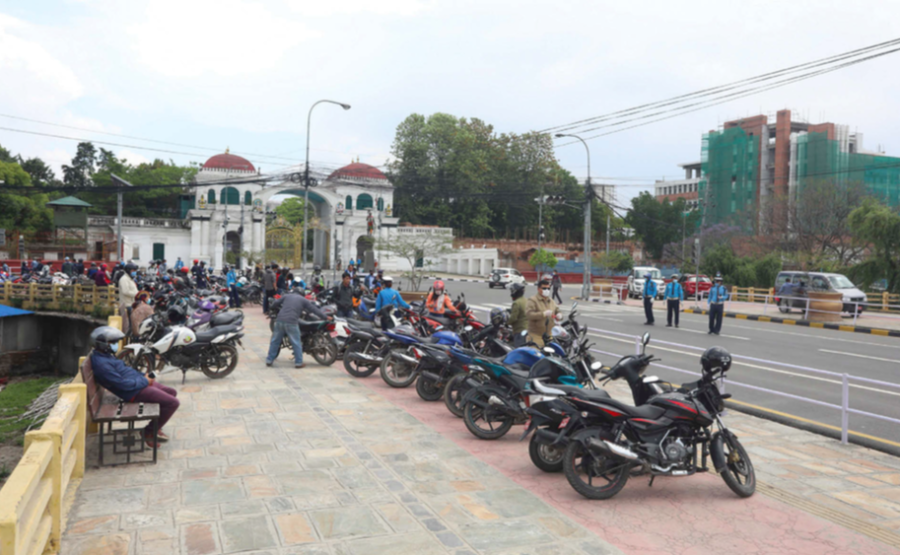After the government on Sunday extended the nationwide lockdown for the third time till May 7, Kathmandu Valley has witnessed a rise in the number of people flouting the lockdown orders.
In the past three days, police have taken action against 4,240 individuals including 1,117 females, for violating stay-at-home rule.
On Sunday, police took action against 1,315 individuals for being outside without any valid reason. The number rose slightly to 1,327 on the following day and jumped to 1,518 on Tuesday.
Similarly, police impounded 1,986 vehicles for breaching the lockdown orders in the past three days.
According to Senior Superintendent of Police Kiran Bajracharya, spokesperson for the Metropolitan Police Office, Ranipokhari, there has been a rise in the number lockdown violators in the recent days.
“However, our personnel have been responding strictly against the violators.” said Bajracharya. “We detain the lockdown violators for three hours, tell them about the risk of Covid-19 and release them.”
The authorities only allow emergency vehicles like ambulances, food delivery vans, garbage trucks and water tankers to operate during the lockdown.
Other vehicles must have passes issued by the District Administration Office for operation, said Superintendent Jeevan Kumar Shrestha, spokesperson for the Metropolitan Traffic Police Division.
The government on April 26 decided to extend the lockdown till May 7 in view of the new Covid-19 cases reported across the country. A total of 57 people have been tested positive for the disease so far. Sixteen people have been discharged from hospitals after successful recovery. The Valley currently has no active Covid-19 case.
Police say despite the lockdown, they have been unable to strictly enforce the restrictions. The number of people entering and exiting the Valley has not stopped.
On Monday morning, seven buses carrying around 160 people from different parts of Kathmandu Valley were stopped by security personnel at Nagdhunga. The passengers had come from Biratnagar. They were held at Nagdhunga for several hours before they were finally allowed entry.
“A few days ago, a group of around 60 people who were trying to enter the Valley on foot were also detained at Nagdhunga. We had to turn them away,” said Inspector Hemanta Bikram Thapa, in charge of Nagdhunga Police Beat.
“Only vehicles offering essential services, like water tankers, ambulances, fuel tankers, and vehicles transporting foodstuffs and patients as well as people having government passes are allowed to enter the valley,” said Thapa.
Police say many people have been using alternative routes to enter the Valley in recent days and they have heightened their surveillance accordingly.
To enforce the lockdown orders, Nepal Police has deployed 9,500 police personnel throughout the Valley. The Armed Force Police personnel have also been deployed to enforce the lockdown.
Frequently asked questions about the coronavirus outbreak
UPDATED as of September 22, 2020
What is Covid-19?
Covid-19, short for coronavirus disease, is an illness caused by the coronavirus SARS-CoV-2, short for severe acute respiratory syndrome coronavirus 2. Common symptoms of the disease include fever, dry cough, fatigue, shortness of breath and breathing difficulties. In severe cases, the infection can cause pneumonia, severe acute respiratory syndrome, kidney failure and even death.
How contagious is Covid-19?
Covid-19 can spread easily from person to person, especially in enclosed spaces. The virus can travel through the air in respiratory droplets produced when a sick person breathes, talks, coughs or sneezes. As the virus can also survive on plastic and steel surfaces for up to 72 hours and on cardboard for up to 24 hours, any contact with such surfaces can also spread the virus. Symptoms take between two to 14 days to appear, during which time the carrier is believed to be contagious.
Where did the virus come from?
The virus was first identified in Wuhan, China in late December. The coronavirus is a large family of viruses that is responsible for everything from the common cold to Middle East Respiratory Syndrome (MERS) and Severe Acute Respiratory Syndrome (SARS). After an initial outbreak in Wuhan that spread across Hubei province, eventually infecting over 80,000 and killing more than 3,000, new infection rates in mainland China have dropped. However, the disease has since spread across the world at an alarming rate.
What is the current status of Covid-19?
The World Health Organisation has called the ongoing outbreak a “pandemic” and urged countries across the world to take precautionary measures. Covid-19 has spread to 213 countries and territories around the world and infected more than 31,405,983 people with 967,505 deaths and 22,990,260 recoveries. In South Asia, India has reported the highest number of infections at 5,557,573 with 88,943 deaths. While Pakistan has reported 306,304 confirmed cases with 6,420 deaths. Nepal has so far reported 65,276 cases with 427 deaths.
How dangerous is the disease?
The mortality rate for Covid-19 is estimated to be 3.6 percent, but new studies have put the rate slightly higher at 5.7 percent. Although Covid-19 is not too dangerous to young healthy people, older individuals and those with immune-compromised systems are at greater risk of death. People with chronic medical conditions like heart disease, diabetes and lung disease, or those who’ve recently undergone serious medical procedures, are also at risk.
How do I keep myself safe?
The WHO advises that the most important thing you can do is wash your hands frequently with soap and water for at least 20 seconds or use hand sanitizers with at least 60 percent alcohol content. Avoid touching your eyes, nose and mouth with unclean hands. Clean and disinfect frequently used surfaces like your computers and phones. Avoid large crowds of people. Seek medical attention if symptoms persist for longer than a few days.
Is it time to panic?
No. The government has imposed a lockdown to limit the spread of the virus. There is no need to begin stockpiling food, cooking gas or hand sanitizers. However, it is always prudent to take sensible precautions like the ones identified above.





 11.12°C Kathmandu
11.12°C Kathmandu















